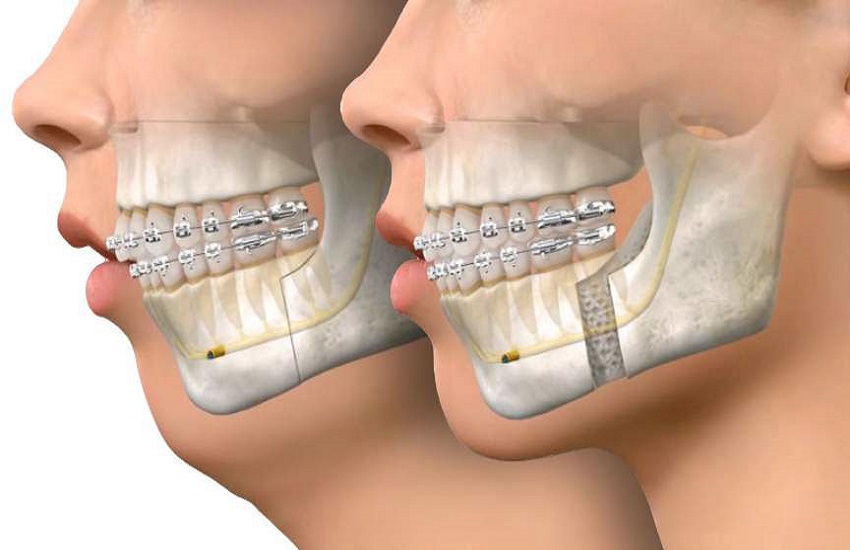Orthognathic surgery, also commonly referred to as jaw surgery, is performed on patients to realign or re-adjust the jaw and the jawline. A maxillofacial surgery dentist primarily performs the surgery alongside an orthodontist. The oral and maxillofacial surgeons (OMS) help perform a variety of dental surgeries. Jaw surgery is recommended for various reasons, such as to repair an injury or an abnormal growth of the jaw.
Why is corrective jaw surgery performed?
The orthodontist performs corrective jaw surgery when the jaw issues also require a specialist in aligning and positioning the teeth and jaw alone. Therefore, in such cases, a surgeon and the orthodontist work together to address the medical condition. Some of the instances wherein a corrective jaw surgery can significantly help a patient are:
- Helping readjust the jawline and teeth for a bite.
- Correcting facial symmetry.
- Repairing an injury.
- Repairing congenital conditions such as a cleft palate.
- Ease pain caused due to temporomandibular joint (TMJ) disorder.
- Improving the jawline to make chewing and biting easier.
- Assist in other medical conditions such as obstructive sleep apnea and mouth breathing.
What are the different types of corrective jaw surgery?
Corrective jaw surgery is of different types such as:
- Maxillary osteotomy. Maxillary osteotomy is a surgery that is performed on the upper jaw, also called the maxilla. This surgery is recommended for those:
-
- Whose upper jaw is either protruded or receded?
- Have a crossbite.
- Have an open bite.
- Suffer from midfacial hypoplasia.
The surgeon cuts the bone of the upper jaw to allow the patient to move it as a unit. This is necessary as he then proceeds to align and fit based on the lower jaw and finally fixes the jaw with screws and plates to help the bone adjust to its new position.
2. Mandibular osteotomy. Opposite to maxillary osteotomy, a mandibular osteotomy is the correction of the lower jaw, also called the mandible, with reference to the upper jaw. This is generally performed for those who have a protruded or receded lower jaw.
In this surgery, the surgeon cuts the bone through the lip of the lower jaw, adjusts it based on the upper jaw and places screws and plates to help the bone readjust to the new position.
3. Bimaxillary osteotomy. A bimaxillary osteotomy is the surgery wherein the surgeon performs the surgery on both jaws. Although operating on both the jaws can be complex, the surgeon is assisted with 3-D technology to plan the surgery.
4. Genioplasty. Genioplasty is the surgery performed on the chin of the patient. This is primarily performed on patients who have a receded chin and can also be performed alongside mandibular osteotomy for the receded lower jaw. In this procedure, the surgeon cuts the part of the chin bone and readjusts it into its new position. It is then held in the new position with screws and plates.
5. TMJ surgery. A TMJ surgery is performed only in those circumstances wherein all other treatment has failed to respond positively for the patient. The difficulty level of the surgery is high in comparison to the others. A few types of TMJ surgery are:
-
- Arthroscopy. This is a surgery wherein a thin tube, also called a cannula, is inserted into the joint to operate the joint.
- Arthrocentesis. This is a minimally invasive procedure wherein very small needles are used to inject fluid into the TMJ to lubricate the joint and reduce inflammation.
- Open joint surgery. Also referred to as arthrotomy, open joint surgery is an invasive surgery wherein the surgeon accesses the jawline through a wide incision in the ear and removes the components that worsen the conditions.
What is the recovery period of the corrective jaw surgery?
Post-surgery, your surgical team would require you to stay in the hospital for up to four days. When planning your shift home, your maxillofacial surgery dentist would provide you with a list of instructions for eating and the maintenance of oral hygiene. It is also completely normal to experience swelling and any other form of discomfort. Your doctor may prescribe medications to help you with your symptoms.
The recovery can take six to twelve weeks with regular follow-ups with your orthodontist. Jaw surgery can cost different and is dependent on several factors such as the surgeon type and the surgery type.
What are the risks involved in corrective jaw surgery?
Jaw surgery is generally considered very safe, but some potential risks involved are:
- Excess bleeding
- Reaction to anaesthesia
- New TMJ pain
- Injury to the jaw nerves
- Jaw fracture
- Relapse of the jawline to the previous position
- Infection
- Difficulty in bite and alignment post-surgery
Concluding remarks
As the name suggests, corrective jaw surgery is typically performed to help in the readjustment and realignment of the jaw and the jawline. This includes your upper jaw, lower jaw, and teeth. In some cases, both undergo corrective surgery with the help of advanced technology such as 3-D technology. Your Maxillofacial surgery dentist would prescribe you the appropriate surgery to help you improve your medical condition based on your medical condition.
A jaw surgery has several benefits: a balanced and symmetrical appearance, better teeth functioning, improved health benefits, and improved speech impairments.
If you live in Tamil Nadu or any other part of the country, you can get corrective jaw surgery in Coimbatore. The jaw correction surgery Coimbatore or the orthognathic surgery in Coimbatore has one of the best facilities to help you treat your dental problems. You can find all information regarding your consultation and your problem at the hospital or at the hospital website which has several blogs.



